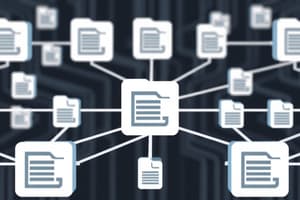Podcast
Questions and Answers
What does the Domain Name System (DNS) provide?
What does the Domain Name System (DNS) provide?
Host-name-to-network address translations
What is the purpose of the Common Internet File System (CIFS)?
What is the purpose of the Common Internet File System (CIFS)?
To create network logins using user authentication.
What are the two techniques used to optimize sequential access?
What are the two techniques used to optimize sequential access?
Free-behind and read-ahead.
What is the purpose of the File-open count?
What is the purpose of the File-open count?
What is the main purpose of the buffer cache?
What is the main purpose of the buffer cache?
What does the 'write ahead' part of journaling mean?
What does the 'write ahead' part of journaling mean?
What is the difference between Global replacement and Local replacement in memory management?
What is the difference between Global replacement and Local replacement in memory management?
The 'virtual address space' is the physical location of where a process is stored in memory.
The 'virtual address space' is the physical location of where a process is stored in memory.
What does the 'Copy-on-Write' strategy allow?
What does the 'Copy-on-Write' strategy allow?
What are the four necessary conditions for a deadlock?
What are the four necessary conditions for a deadlock?
What is the purpose of the 'Lazy swapper' in memory management?
What is the purpose of the 'Lazy swapper' in memory management?
What are the three file operations used for writing data to a file?
What are the three file operations used for writing data to a file?
What is the purpose of the 'page address extension' (PAE)?
What is the purpose of the 'page address extension' (PAE)?
What are the three file operations used when reading data from a file?
What are the three file operations used when reading data from a file?
What is the difference between the 'Shared lock' and 'Exclusive lock'?
What is the difference between the 'Shared lock' and 'Exclusive lock'?
What does the term 'File Session' denote?
What does the term 'File Session' denote?
What does the term 'Positioning time' refer to?
What does the term 'Positioning time' refer to?
How do 'Striped mirrors' (RAID 1+0) or 'mirrored stripes' (RAID 0+1) improve performance and reliability?
How do 'Striped mirrors' (RAID 1+0) or 'mirrored stripes' (RAID 0+1) improve performance and reliability?
What is the purpose of the system call 'ioctl'?
What is the purpose of the system call 'ioctl'?
What does 'Virtual File System' (VFS) layer do?
What does 'Virtual File System' (VFS) layer do?
What is the difference between the 'Most Frequently Used' (MFU) algorithm and the 'Least Frequently Used' (LFU) algorithm?
What is the difference between the 'Most Frequently Used' (MFU) algorithm and the 'Least Frequently Used' (LFU) algorithm?
What is the primary purpose of the 'Mount table'?
What is the primary purpose of the 'Mount table'?
Flashcards
Root Partition
Root Partition
The partition that holds the operating system (OS).
DNS
DNS
Translates hostnames to network addresses.
NIS
NIS
Provides network information like usernames and passwords.
CIFS
CIFS
Signup and view all the flashcards
File Session
File Session
Signup and view all the flashcards
NFS
NFS
Signup and view all the flashcards
VFS
VFS
Signup and view all the flashcards
Journaling
Journaling
Signup and view all the flashcards
Journal Write
Journal Write
Signup and view all the flashcards
Journal Commit
Journal Commit
Signup and view all the flashcards
Checkpoint
Checkpoint
Signup and view all the flashcards
FCB
FCB
Signup and view all the flashcards
Device Drivers
Device Drivers
Signup and view all the flashcards
Mount Table
Mount Table
Signup and view all the flashcards
Open-File Table
Open-File Table
Signup and view all the flashcards
File-Open Count
File-Open Count
Signup and view all the flashcards
Shared Lock
Shared Lock
Signup and view all the flashcards
Exclusive Lock
Exclusive Lock
Signup and view all the flashcards
Transfer Rate
Transfer Rate
Signup and view all the flashcards
Access Latency
Access Latency
Signup and view all the flashcards
Head Crash
Head Crash
Signup and view all the flashcards
RAID
RAID
Signup and view all the flashcards
Mirroring (RAID 1)
Mirroring (RAID 1)
Signup and view all the flashcards
Virtual Memory
Virtual Memory
Signup and view all the flashcards
Demand Paging
Demand Paging
Signup and view all the flashcards
FIFO
FIFO
Signup and view all the flashcards
Study Notes
Definitions and Terms
- Deadlock Detection: A method to identify deadlocks in a computer system.
- Client-Server Model: A computing model where one system (client) requests services from another system (server).
- Journaling File Systems: Systems that log actions to a journal before they are executed on disk. This provides data integrity and recovery capabilities.
- NFS (Network File System): A protocol and implementation for allowing access to remote files over a network.
- VFS (Virtual File System): A layer that distinguishes local and remote files. It hides the underlying differences between file systems.
- Journaling: A system for logging changes to file/data systems, enabling recovery in case of failures.
- Journal Write: Record the transaction in a log file.
- Journal Commit: Write the transaction commit block to disk
- Checkpoint: Write the contents of updates to their locations.
- FCB (File Control Block): A structure containing information about a file, including its location, size, and permissions.
- Root Partition: Contains the operating system (OS).
- DNS (Domain Name System): Translates hostnames to network addresses.
- NIS (Network Information Service): Provides user authentication for network logins.
- CIFS (Common Internet File System): A protocol used for network file sharing.
- File Session: A series of access operations to a file.
- RAID (Redundant Array of Inexpensive Disks): A technology that uses multiple disks to improve data reliability and performance.
Additional Concepts
- Demand Paging: A memory management technique where pages are loaded into memory only when they are needed.
- Banker's Algorithm: An algorithm for resource allocation that prevents deadlocks by considering the needs of all processes.
- Deadlock Conditions: Mutual Exclusion, Hold and Wait, No Preemption, Circular Wait
- File Attributes: Includes the file's name, identifier, type, location, size, protection and date-time.
- File Operations: Create, write, read, reposition, delete, truncate, open, close.
- Buffer Cache: A memory area for frequently used blocks.
- Page Cache: Caches pages in memory to speed up access.
- Virtual Memory: A memory management technique that uses disk space as an extension of RAM.
- Lazy Swapper: A memory management technique that defers loading pages into memory until they're needed.
- Copy-on-Write (COW): Allows sharing of the same file by parent and child processes.
- Least Frequently Used (LFU) Algorithm: A method for replacing pages in memory based on their frequency of use.
- Most Frequently Used (MFU) Algorithm: An algorithm for replacing pages in memory based on their usage frequency.
- Global Replacement: Replacing a frame from any available frame.
- Local Replacement: Replacing a frame only from the allocated resource for that process.
- Page Address Extension (PAE): Extends the addressable memory space to accommodate more memory per each application.
- Resource Type, Allocation, Request, and Available: Management of resources of each type for multiple processes.
System-Level Concepts
- Device Drivers: Manage I/O devices.
- Mount Table: Stores information about file system mounts; type of file system, and location of the corresponding file system.
- System-Wide Open-File Table: Contains a copy of the FCB for each open file.
- Per-Process Open-File Table: Contains pointers to appropriate entries in the system-wide open-file table.
- Collisions: A condition where multiple file names hash to the same location.
- Free-Behind and Read-Ahead: Techniques to optimize sequential file access.
- Transfer Rate: Data transfer rate between computer and drive.
- Positioning Time: Time taken to move the head to a specific location in a disk to execute a read/write operation, including seek time and rotational latency.
- Head Crash: Mechanical disk failure when the disk head touches the surface of a disk, causing damage.
- Access Latency: Total access time for an I/O operation, calculated as the sum of average seek time, and latency.
- RAM Drives Devices that appear as raw blocks of memory.
- Error Correction Code (ECC): Detects and corrects errors in data transfers.
- Mean Time to Repair (MTTR): Average time to repair a system failure.
- Mean Time to Data Loss (MTTDL): Average time before data loss occurs, due to equipment failures, etc.
Tutorials/Study Assignments
- FIFO: First-In, First-Out scheduling, often used in data queues and processes.
- Rendezvous: A mechanism to synchronize processes, often used in shared memory.
- Futex: Fast Userspace Mutex, a user-space synchronization primitive.
- Ioctl: System call to manipulate device parameters.
- Sync, Echo, and Buffer: Mechanisms used for data synchronization, communication, and buffering.
- Memory Allocation Schemes with internal fragmentation: Fixed Partitioning and Paging
- LRU, Second Chance, FIFO, and RECENCY BIT: Page Replacement algorithms for virtual memory.
- CPU Utilization: Refers to the percentage of CPU time being utilized by a task or a collection of processes.
- Decrease in Multiprogramming: A way to improve computer system efficiency.
- Disk Scheduling: Scheduling the order in which disk requests are served.
- Turnaround Time: The whole time taken for a process to complete execution.
- Major and Minor Numbers Numbers used to distinguish between different devices.
- Mandatory vs Discretionary Access Control: Different approaches to file access protection.
Other important Terms
- File-open count: Number of times a file is opened.
- Shared Lock: Similar to read-lock.
- Exclusive Lock: Similar to write-lock.
Studying That Suits You
Use AI to generate personalized quizzes and flashcards to suit your learning preferences.




